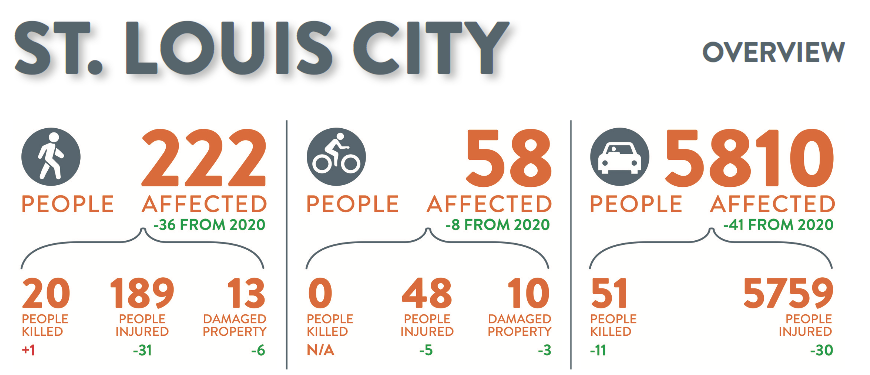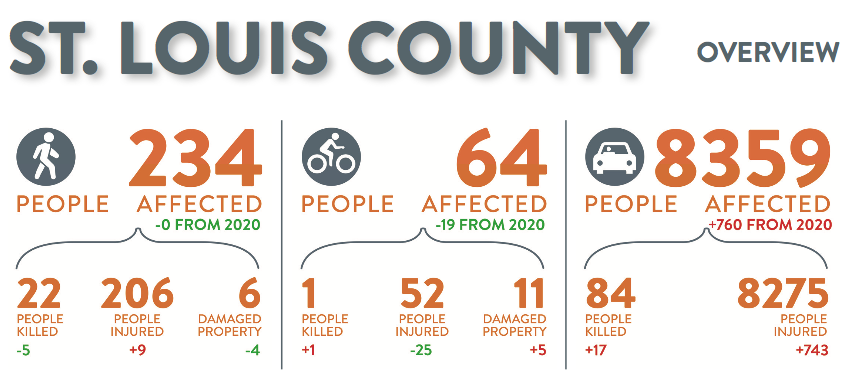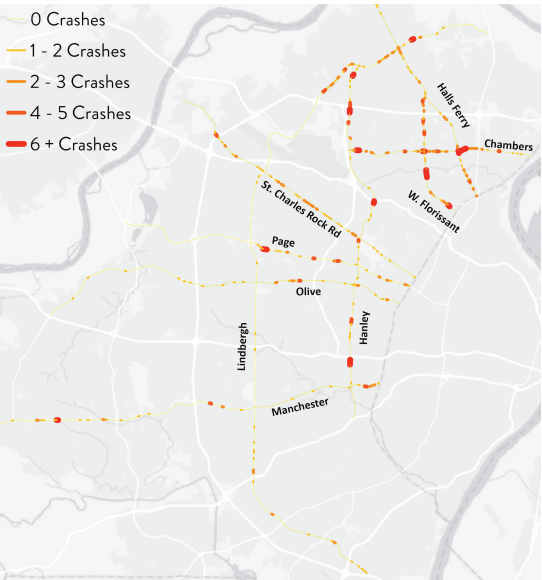178 people have died as a result of traffic violence in 2021. For the 4th year in a row pedestrian fatalities have risen in the City of St. Louis and for the first time, total traffic fatalities eclipsed 100 in St. Louis County. Trailnet, a local walking and biking advocacy non-profit, believes that all traffic crashes are unacceptable and completely preventable. Trailnet’s 2021 St. Louis City and County Crash Report investigates the trends, characteristics, and provides solutions on how to improve safety for people walking, biking, and using transit
From Trailnet’s Crash Reports, we know where bike, pedestrian, and fatal car crashes happen. Many of these crashes occurred on roads that Trailnet calls the High Crash Corridors. These High Crash Corridors are often characteristically similar. Dangerously wide streets with a posted speed limit of 35 MH or higher prioritize moving cars over the safety of people who walk, bike, and use transit. Over the last 5 years in the City of St. Louis, 9 roads, which account for 1.5% of the City’s total lane miles are responsible for 40% of pedestrian crashes and 46% of pedestrian fatalities. In St. Louis County, 8 roads account for 34% of pedestrian crashes and 45% of pedestrian fatalities.
Despite some successes, much of the year was marked by a continuation of the status quo. The region lacks a unified, focused, or appropriately-funded approach to making streets safer. Across the region, all levels of government should re-evaluate how they approach the life-shattering problem of crashes and not accept them as routine accidents.
An alternative to the status quo is an approach that is both comprehensive in its scope and based on need. At Trailnet we see this approach as driven by data – as we have collected here – but also informed by the needs expressed below:
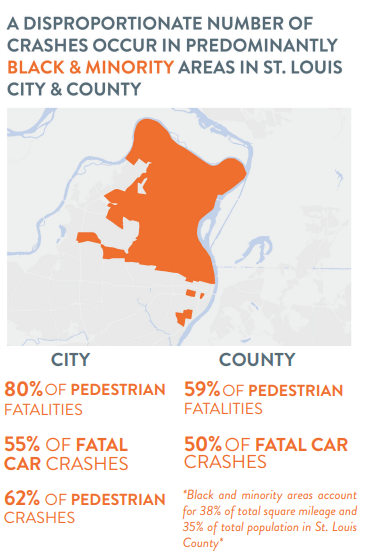
- Address Pedestrian High Crash Corridors immediately, specifically ones in North St. Louis City and County. As mentioned, a handful of roads in St. Louis City and County contribute to a disproportionate number of pedestrian crashes. A majority of these roads run throughout North St. Louis City and St. Louis County and year after year continue to affect the safety of the people who travel along those streets. Roads like Kingshighway, West Florissant, Natural Bridge, Chambers, North Grand, and many others need massive infrastructure overhauls immediately in order to increase safety for the people who walk, bike, drive, and take transit along those corridors.
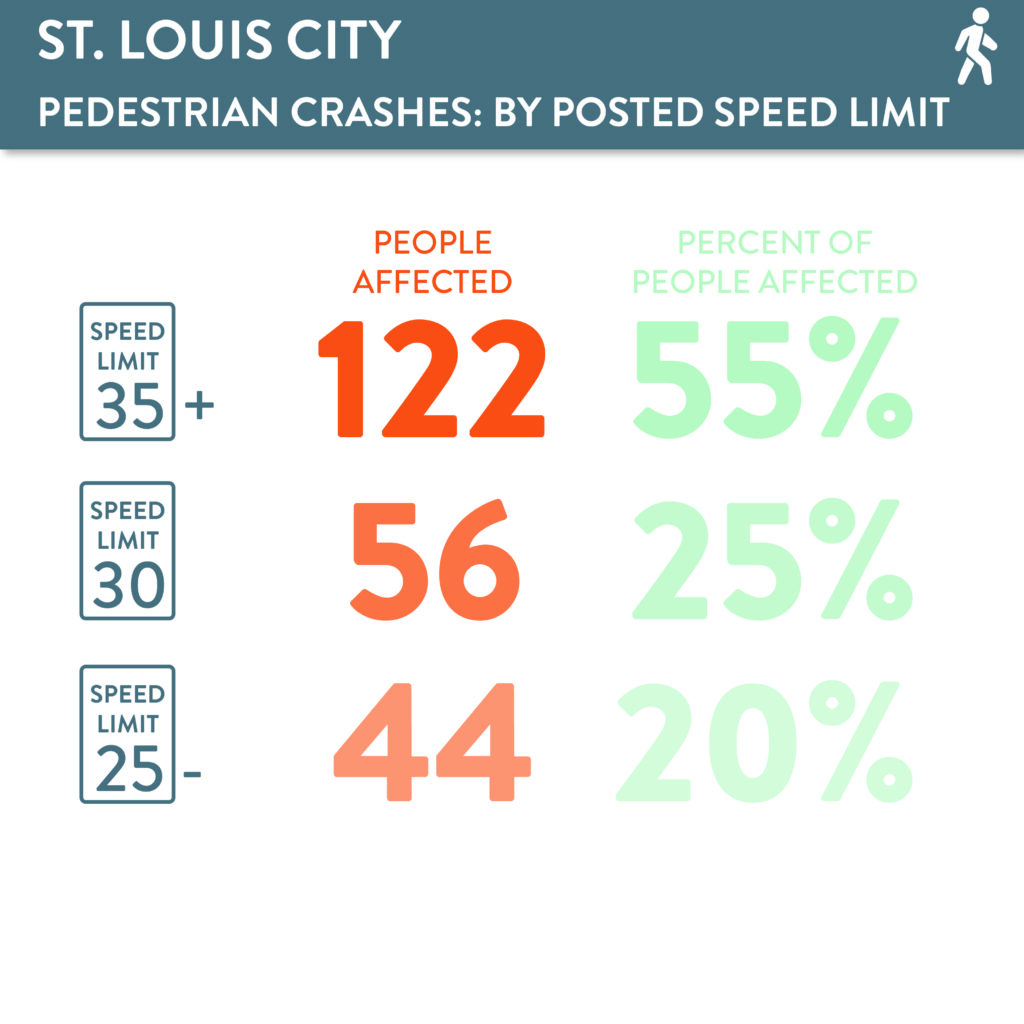
- Address Excessive Speeding through Street Design and Signage: Speed continued to be the biggest contributing factor to bike, pedestrian, and car crashes. In St. Louis County and City, 74% of pedestrian crashes occurred on streets with a posted speed limit of 30 MPH or higher. 95% of pedestrian fatalities in St. Louis City and County occurred on roads with a posted speed limit of 30 MPH or higher. A strategy of reducing all local roads to 20 MPH, all collectors (and some arterials) to 25 MPH combined, and a plan to strategically implement traffic calming infrastructure to reinforce these new speed limits would have major positive safety impacts. Utilizing speed humps, neighborhood traffic circles, curb extension, center median island, and other traffic calming solutions will drastically increase the safety of people walking, biking, driving, and using transit across the region.
- Safety Improvements Near Bus Stops Safety for people walking and biking and transit use are intrinsically connected. 36% of pedestrian crashes and 45% of pedestrian fatalities occur within 200 feet of a MetroBus stop in St. Louis City. These disproportionate numbers are part of a larger trend to improve safety not only for people walking and biking but to improve the MetroBus system in general. Small-scale projects like pedestrian refuge islands at mid-block crossing points, pedestrian-level lighting near the bus stop, high visibility crosswalks, and raised crosswalks are proactive solutions to improve safety for people who walk and take transit. Large-scale strategies like adding dedicated bus lanes and increasing service frequency could boost transit ridership, and reshape deadly roads into people-centers streets.
These strategies are not the only actions that need to be taken in order to reduce traffic violence on St. Louis roads. In the 2020 Trailnet Crash Report, we also highlighted several other solutions that should be addressed alongside the solutions mentioned in the 2021 report. Those solutions include a greater number of pedestrian enhancements along major roads, neighborhood traffic calming projects, distracted driving legislation for the State of Missouri, mandatory roadway education, and an increased number of protected bike lanes.
The actions outlined above are what Trailnet views as the most pressing needs to reduce traffic fatalities in the St. Louis region. It is time to comprehensively address traffic violence in the St. Louis region.
Our goal should be ZERO traffic fatalities on our roadways, any number higher than that is a sign of collective failure and disregard for the safety of the people living in the St. Louis region.

